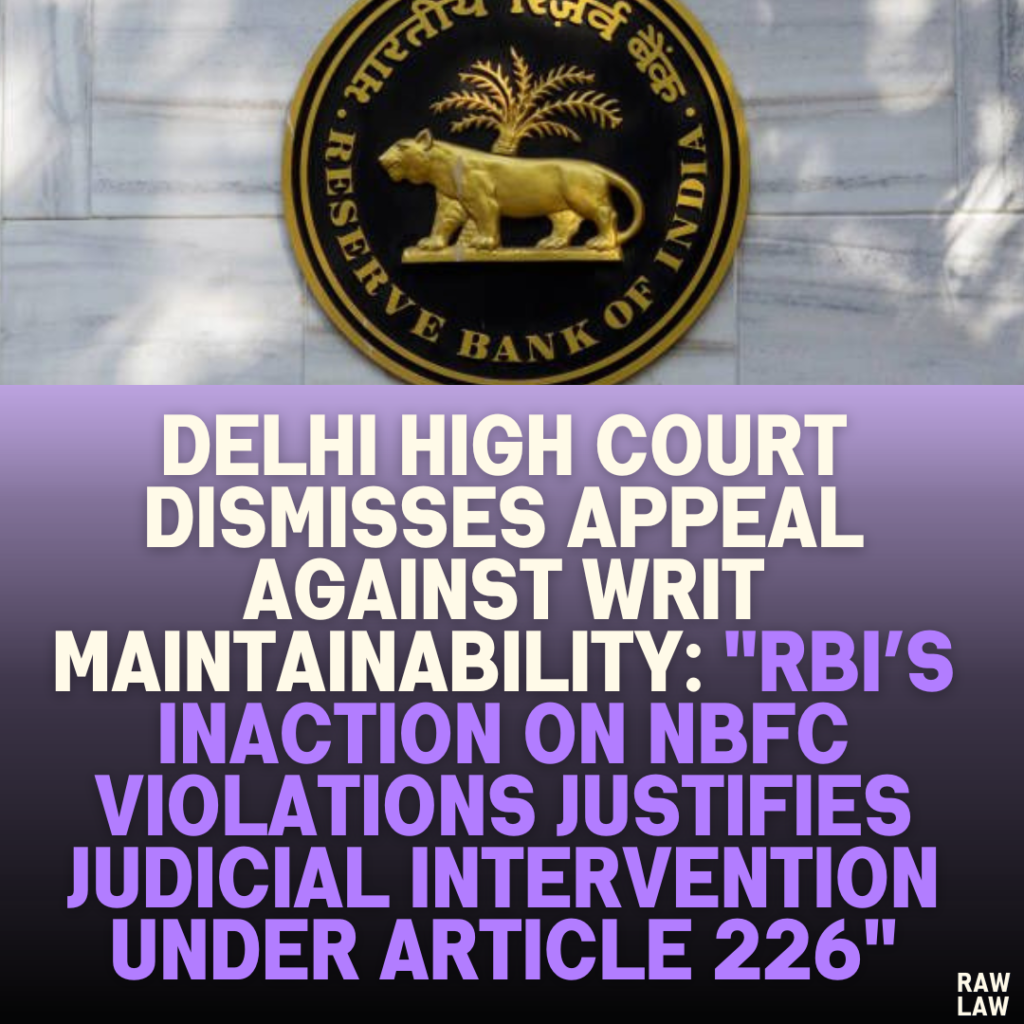Court’s Decision
The Delhi High Court dismissed the Letters Patent Appeal (LPA) filed by the suspended director of M/s Exclusive Capital Limited (ECL). The court upheld the Single Judge’s ruling that the writ petition under Article 226 of the Constitution of India was maintainable, even as proceedings were pending before the National Company Law Tribunal (NCLT) and the National Company Law Appellate Tribunal (NCLAT). The High Court observed that the RBI had failed to act on evident regulatory breaches by ECL and noted that such inaction justified judicial intervention through a writ of mandamus.
Facts of the Case
- Incorporation of ECL:
ECL, a Non-Systemically Important Non-Deposit Taking Non-Banking Financial Company (NBFC), was incorporated in 1994 and registered with the RBI. - Fundraising and Regulatory Breaches:
- ECL issued Optionally Convertible Debentures (OCDs) worth ₹315 crores between October 2021 and March 2022, which breached the leverage ratio prescribed under RBI regulations.
- To rectify the breach, the OCDs were converted into Compulsorily Convertible Preference Shares (CCPS) through a resolution passed in September 2022. However, this conversion was conducted without RBI’s prior approval, violating regulatory guidelines.
- Complaints of Siphoning and Mismanagement:
- Allegations were raised against the directors of ECL regarding siphoning funds, non-compliance with statutory duties, and mismanagement.
- These allegations led to a company petition being filed before the NCLT. The tribunal found the conversion of OCDs to CCPS to be non-bona fide, constituting oppression of minority shareholders.
- NCLT and NCLAT Proceedings:
- The NCLT suspended ECL’s Board of Directors and appointed a retired High Court Judge as an administrator.
- NCLAT upheld the NCLT’s findings but modified the administrator’s role to that of an observer.
- Writ Petition Filed Under Article 226:
Respondent No. 1 (a shareholder in ECL) filed a writ petition before the Delhi High Court, seeking directions to compel RBI to act on complaints and exercise its statutory powers to address the alleged violations.
Issues Considered
- Maintainability of the Writ Petition:
Could the High Court entertain a writ petition under Article 226 when similar issues were pending before the NCLT and NCLAT? - Jurisdiction of RBI:
Did the RBI fail in its statutory duty to address violations by ECL under the Reserve Bank of India Act, 1934 (RBI Act)? - Scope of Judicial Intervention:
Was the Single Judge justified in issuing interim directions while addressing the maintainability of the petition?
Petitioner’s Arguments (Suspended Director of ECL)
- The writ petition was not maintainable as similar issues were already being adjudicated by NCLT and NCLAT.
- The Single Judge issued directions amounting to final relief without hearing the appellant on merits, violating the principles of natural justice.
- Respondent No. 1 lacked locus standi as it purchased CCPS after the initiation of the NCLT proceedings.
- RBI had already initiated an inquiry, and additional judicial directions were unnecessary.
Respondent’s Arguments (Shareholder and RBI)
- RBI had failed to act on evident regulatory breaches by ECL, despite receiving complaints and conducting an inspection.
- Reliefs sought in the writ petition (directions to RBI) were outside the jurisdiction of NCLT/NCLAT, which could not enforce RBI’s statutory duties.
- RBI’s inaction justified judicial intervention under Article 226 to ensure compliance with its public duties.
Analysis of the Law
- Jurisdiction Under Article 226:
- The court reaffirmed that a writ of mandamus could be issued against public authorities for failing to exercise statutory powers. The judgment relied on CAG v. K.S. Jagannathan, where the Supreme Court held that courts could compel public authorities to perform their statutory duties.
- The court emphasized that RBI’s role as the regulator of NBFCs is crucial, and its failure to act warranted judicial scrutiny.
- Concurrent Jurisdiction of NCLT/NCLAT:
- The court clarified that NCLT/NCLAT proceedings under the Companies Act, 2013, did not bar the High Court from addressing RBI’s inaction under the RBI Act.
- While NCLT and NCLAT deal with corporate governance issues, only RBI has jurisdiction over NBFC regulatory violations.
- Interim Directions by the Single Judge:
- The Single Judge was well within jurisdiction to issue interim directions compelling RBI to act, as this fell within the scope of Article 226.
Precedent Analysis
The court cited IFB Agro Industries Ltd. v. SICGIL India Ltd., where the Supreme Court held that matters within the jurisdiction of statutory regulators must be adjudicated by them. This case supported the view that RBI alone could address regulatory breaches by NBFCs like ECL.
Court’s Reasoning
- Maintainability:
The court found that the writ petition sought enforcement of RBI’s statutory duties, a relief that could not be granted by NCLT/NCLAT. Hence, the petition was maintainable. - RBI’s Inaction:
- Despite identifying significant violations by ECL (e.g., breach of leverage ratio, unauthorized issuance of CCPS), RBI failed to take corrective action.
- The court emphasized that regulatory inaction jeopardizes public interest and investor confidence.
- Natural Justice:
The appellant’s claim of not being heard was rejected, as both maintainability and merits were extensively argued before the Single Judge.
Conclusion
The High Court upheld the Single Judge’s findings, emphasizing that judicial intervention was necessary to ensure RBI fulfilled its statutory obligations. The court dismissed the appeal and maintained the interim directions issued by the Single Judge.
Implications of the Judgment
- Strengthening Accountability:
The judgment reinforces that regulatory bodies like RBI must act decisively on statutory breaches to protect public and investor interests. - Judicial Oversight:
It underscores the judiciary’s role in ensuring compliance with public duties when regulatory authorities fail to act. - Wider Scope of Article 226:
The case highlights the expansive jurisdiction of High Courts under Article 226, particularly in addressing regulatory lapses by public authorities.
